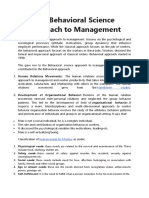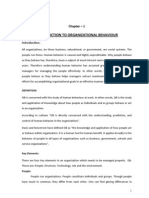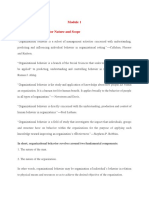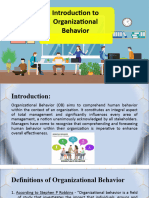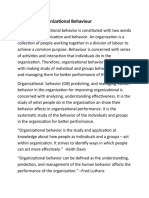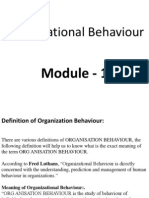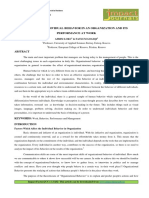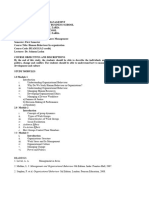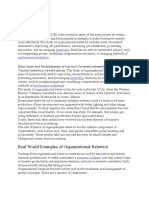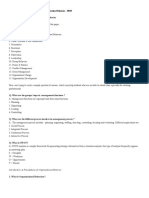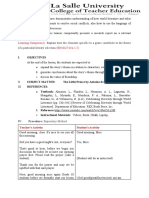Unit 4 Understanding Human Behaviour: Objectives
Unit 4 Understanding Human Behaviour: Objectives
Uploaded by
ilasehrawatCopyright:
Available Formats
Unit 4 Understanding Human Behaviour: Objectives
Unit 4 Understanding Human Behaviour: Objectives
Uploaded by
ilasehrawatOriginal Title
Copyright
Available Formats
Share this document
Did you find this document useful?
Is this content inappropriate?
Copyright:
Available Formats
Unit 4 Understanding Human Behaviour: Objectives
Unit 4 Understanding Human Behaviour: Objectives
Uploaded by
ilasehrawatCopyright:
Available Formats
UNIT 4
Objectives
UNDERSTANDING HUMAN BEHAVIOUR
Indian Environment: The Changing Scenario
After going through this unit you should be able to understand: importance of understanding human behaviour.
Structure 4.1 4.2 4.3 4.4 4.5 4.6 4.7 4.8 4.9 4.10 4.11 4.12 4.13 4.14 4.15 4.16 Introduction Models to Understand Human Behaviour Implications for the Organisation Personality Determinants of Personality Type and Trait Approaches to Personality Theories of Personality Importance of Personality Attitudes Attitudes and Organisation Values Socialisation's Influence on Personality, Values and Attitudes Schein Socialisation Model Summary Self-Assessment Questions Further Readings
4.1
INTRODUCTION
It is very essential to understand human behaviour in today's world as the existence of the organisation depends op the employees/individuals. Without understanding human behaviour it is very difficult to work in an organisation. In order to understand human behaviour let us see how the perception of human being has changed from time to time. All organisations are composed of individuals, with different personality, attitudes, values, perception, motives, aspirations and abilities. The main reason to understand behaviour is that individuals are different. No two individuals are similar. In the early studies, theories of organisation and management treated people as though they were the same; scientific management was based on the similarities among workers, not the differences. In contrast, modern theories of human behaviour are based upon the differences among people and how those differences can affect the organisation. Individual differences are many for example some employees are motivated to work and some are not. This can be due to several reasons, and can be known by further reading the unit. Before we proceed to understand human behaviour, it is better to know what the term `behaviour' means. Behaviour can be defined as a response/s which is observed directly/indirectly. Direct observation is possible by studying the responses of people to a work environment. Indirect observations are decision
Social Processes and Issues
making processes and attitudes, in terms of results or how people describe them verbally. Human behaviour is very much unpredictable. In behaviour we cannot assume one set pattern of behaviour. Lavitt classified behaviour as: (i) Caused behaviour, (ii) Motivated behaviour, (iii) Goal oriented behaviour. From these observations it can be understood that behaviour is a dependent factor. By understanding behaviour one can predict, direct, change and control behaviour of individuals or group. There are generally four basic assumptions regarding nature of people: individual differences, a whole person, caused behaviour (motivation) and value of the person (human
dignity).
In an organisational set up it is essential for managers to understand behaviour. as they are constantly with people, interacting with them in terms of communication (either written or oral) in terms of work (either by specifying the work and getting things done). Understanding past behaviour is important for developing effective human skills, and it also provides a framework for predicting behaviour. It also gives an idea to managers as to how behaviour is similar in certain circumstances and changing in changing environmental conditions. Another skill which an effective manager or leader needs is the ability to direct, change and control behaviour. Managers have to understand that there are-going to be individual differences among the employees, as no individual is similar to other. Each individual is unique by themselves. Then one has to understand that each individual has to be taken care of as a whole person by taking care of. his needs as well as training and making him up to date in terms of work. Ultimately human beings have to be treated with respect only then you can expect effective performance. With the following descriptions you will be able to understand the concept better. Dan's analyses the nature of people in terms of four assumptions. 1. Individual Differences Behaviour is the result of interaction between individual characteristics and the characteristics of the environment in which the behaviour occurs. Each person has a unique combination of characteristics. Some of these characteristics are present from birth; others develop over time. These can be called as inherited and learned characteristics. Although there are some inherited Table 1: Learned Characteristics and its Effect on Behaviour Characteristics Tolerance for conflict Relative importance of Behaviour Perceived role conflict Expressed job satisfaction Relationship found Less role conflict with greater tolerance for conflict "Extrinsic Managers" expressed less job satisfaction extrinsic versus intrinsic rewards Stronger work ethic associated with greater attendance High general interest of performance diversity associated with better performance More stress with emphasis on external locus of control
Value or work ethic
Attendance
Diversity of interests
Salary based measure
Locus of control
Experienced job stress
characteristics, but these are very few, and not so significant. Learned characteristics are very important. Individual differences can be because of environment, personal and psychological factors. It is also due to physical and social factors. Learned characteristics are acquired as people grow, develop and interact with their environments. This is depicted by Table 1. `Environmental factors' are characteristics of the broader environment such as economic conditions, social and. cultural norms, and political factors that can affect the individuals behaviour. Personal factors include physical and personal attributes e.g., age, sex, race, education and abilities, psychological factors are less observable. They are mental characteristics and attributes such as values, attitudes, personality and aptitudes that affect behaviour through complex psychological processes. These are studied, in the subsequent units. All aspects of the physical world that can be seen, heard, felt, smelled or touched are part of the physical environment of behaviour. The social environment of an individual includes relationships with family, friends, co-workers, supervisors and subordinates and membership in groups such as unions. The behaviour of others (as distinct from the individuals relationship with them) is also part of an individual's social environment. Any 'norms, rules, laws or reward systems that originate with other individuals or groups help to form an individual's social environment. 2. A Whole Person
Indian Environment: The Changing Scenario
When an employee works in an organisation, the organisation takes care of that person by making him effective, as a worker and as a person. 3. Caused Behaviour (Motivation)
People's behaviour is need based. By fulfilling these needs he is motivated positively and there occurs effective performance. So the management in the organisation has to take care of these needs in order to have an effective performance. The management can show them how certain actions will increase their need fulfilment and if not; how it decreases their need fulfilment. 4. Value of the Person (Human Dignity)
People have to be treated with respect and as individuals and they can not be treated like machines as how scientific management use to treat them. By recognising them and treating them with uniqueness the value of the person gets increased. By this we can understand how the concept of treating human beings from machines to human capitals have evolved. If one accepts the fact that human skill development is necessary then managers and leaders must have necessary understanding in order to influence the behaviour of other people. It was felt that the managers acquire three levels of expertise. Firstly they have to understand the past and current behaviour, so that they are able to predict behaviour and than they learn to direct change, and control behaviour.
4.2
MODELS TO UNDERSTAND HUMAN BEHAVIOUR
Early classical approaches made the assumptions that people are naturally lazy and self-serving, neutral, or positive and self-motivated. In simpler terms they need to be pushed and controlled and kept under surveillance, never to be trusted to put in a good day's work by themselves. Economic rewards were the only one considered, and close autocratic supervision was suggested. Systems and contingency theorists viewed people as adaptable and felt that much of behaviour was learned and not attributable to predispositions to be negative or positive.
Social Processes and Issues
Likert, Mc Gregor and Bennis who developed and extended the findings of humanrelations theorists had a positive view of human nature. Employees were seen as striving for personal and social well-being. If left alone, they would work hard for the intrinsic satisfaction of a job well done- The emphasis was on democratic decision making and leadership. Jobs were to be challenging and allowed the individual employee to be creative.
Models of Human Behaviour
Psychoanalytic Model: Freudian approach depends on conflict model of humans. By using clinical techniques of free association and psychotherapy Freud felt that behaviour is not always consciously explained. "Unconscious" is the major factor which guides the individual's behaviour. Freud felt that the individual's behaviour depends on three factors: (i) id, (ii) Ego and (iii) Super ego. Id: By Id it means pleasure. To certain degree of having Id in an individual is constructive but may also lead to destructive tendencies like being aggressive, dominating, fighting and generally destroy. This kind of instinctive is more dominating in childhood. But once individuals develop and mature they learn to control the id. But it is always unconscious. Throughout life the `id' becomes important source of thinking and behaving. Ego: Ego represents `conscious' stage in one's behaviour. Though Id comes in conflict with ego, the ego depends on the super ego. Superego: It represents "conscience". An individual is not aware of the superego's functioning. The conscience is dependent on two factors that is cultural values and moral of a society. Superego's development depends mostly on parent's influence. Once the child grows up the child will unconsciously identifies with parents value and morals. There is always tussle between id, ego and superego. The degree of each of them varies from person to person. So the variations in individual's behaviour can be better understood with the help of this model. But the modern theories have severely criticised this theory as it is not based on any empirical facts and as such it can not be accepted in totality. But the concept of "unconscious" is a significant contribution in understanding specific behaviour of humans. Existential Model: This model is not scientifically based. It's base is literature and philosophy. The existentialists believe that the depersonalising effects of this environment forces individuals to make their own destiny. So the individuals shape their own identity and make their "existence" meaningful and worthwhile to themselves. This is more true and happening in today's urbanisation. Because people have become so materialistic and busy, they do not have time for traditional values and norms and it becomes impractical sometimes to follow them. Existential model is, especially true when you are employed in today's world. Though this model is not scientific it can be definitely be used in understanding human behaviour.
Internal vs. External Determinants of Behaviour
Environment plays a major role in shaping behaviour and genetic endowment and personality development is influenced by our historical heritage.
Personality vs the Environment
Both personality and situational variables must be taken into account in order to explain an individual's behaviour but a focus on the environment is as important or perhaps slightly more important than focusing on personality traits.
Indian Environment: The Changing Scenario
Cognition vs the Environment
To understand one's behaviour all we have to know is the individual's past responses to similar (stimulus) situations and the rewards or punishments that followed that response. There are two models which come out of these approaches: 1. Behaviouristic Model: In this model the behaviour is dependent on two factors i.e., stimulus and response. Learning occurs with this kind of model. Pavlov and Watson with their research felt that behaviour can be best understood by stimulus and response. Behaviourist model is represented as: S - R (Stimulus-Response) 2. Cognitive Model: S-OR-R. This model emphasises the positive and free-will factors of human beings and uses concepts such as expectancy, demand and incentive. Tolman with his experiments found that the basis of learning as of `expectancy' which is understood as one particular event leading to a particular consequence i.e., goal. Human behaviour is based on these goals. The cognitive model is represented as: S - O - R (Stimulus-Organism-Response model) Both approaches see learning and the environment as having a major impact on behaviour. From these different approaches it can be said that: i) Behaviour is caused by instincts, genetic background and personality traits that are formed at an early age. Change is very difficult for the individual and that one's capacity is severely limited. Behaviour is mostly learned through our interactions with the environment. Present events rather than past events are important. Even though there are some limitations on. one's capacities, one is capable of great amounts of change.
ii)
4.3
IMPLICATIONS FOR THE ORGANISATION
Behviour of individuals is caused, and follows a pattern, because of this, behaviour is unpredictable. Study of behaviour is however, rewarding and necessary for management. It is doubtful whether the manager can perform his tasks satisfactorily without developing a fair degree of understanding of the people around him. Any attempt to learn why people behave as they do in organisations requires some understanding of individual differences. Managers spend considerable time making judgements about the fit between individuals, job tasks and from these approaches it can be concluded that there is an overwhelming consensus that the, environment has a much greater effect than it is believed. The implications for organisations are important. It means that large areas of human behaviour are modifiable. Organisational design, training and development can have a profound impact on the behaviour of the members of an organisation.
Social Processes and Issues
4.4
PERSONALITY
Gordon Allport defined Personality as the dynamic organisation within the individual of those Psycho-Physical Systems that determine his unique adjustments to his environment. Personality can be described more specifically as "how a person affects others, how he understands and views himself and his pattern of inner and outer measurable traits." From this definition, it can be understood one's physical appearance and behaviour affects others. Understanding oneself means one is unique with a set of attitudes and values and a self-concept. Finally, the pattern of measurable traits refers to a set of characteristics that the person exhibits. Some of the other definitions are "Personality is a vehicle to integrate perception, learning, values and attitudes and thus to understand the total person." "Personality is an individual's total sense of self, it is an organising force for the persons particular pattern of exhibited traits and behaviours." "Personality is the culmination of experiences and genetic influences." Personality is influenced by the personal life and where he is working.
4.5
DETERMINANTS OF PERSONALITY
Personality is the result of both heredity and environment and also the situation.
Heredity
Heredity refers to those factors that were determined at conception. Physical appearance, temperament, energy level and biological rhythms are the characteristics which are generally influenced by one's Parents' i.e., One's Biological, Physiological and Inherent Psychological Make up. The Heredity approach feels that personality of an individual is the Molecular Structure of the genes, located in the chromosomes.
Environment
Culture plays an important role in the formation of personality, i.e., early conditioning, the norms among the family, friends and social groups. With the socialisation process in the group, personalities are altered over time.
Situation
Though an individual personality is constant, it does change depending on the situation. Different demands in different situations call forth different aspect of one's personality. The relationship of these three factors affects the formation and development of Personality. Psychological inheritance is entirely an internal contribution. Group and culture are the early environmental factors that form later behaviour. Family and social setting during the early stages of education are the important factors which influences the initial formation of personality. Whatever the child learns here lasts for life time. Later in life, it is the Peer groups or Primary affiliations at work, social activities which shape the Personality.
10
4.6
TYPE AND TRAIT APPROACHES TO PERSONALITY
Indian Environment: The Changing Scenario
The traditional viewed individuals as Shy, Lazy, Melancholy, Ambitious, Aggressive. These were called a Traits. Groups of these traits were then aggregated to Personality types.
Trait Approach
Cattel (1973) identified 16 source traits/Primary Traits. These traits were found to be generally steady and constant sources of behaviour. But there was found to be no scientific relevance. Figure 1: Sixteen Source Traits 1) 2) 3) 4) 5) 6) 7) 8) 9) 10) 11) 12) 13) 14) 15) 16) Reserved - Outgoing Less intelligent - More intelligent Affected by feelings - Emotionally stable Submissive - Dominant Serious - Happy go Lucky Expedient - Conscientious Timid - Venturesome Tough minded - Sensitive Trusting - Suspicious Practical - Imaginative Forthright - Shrewd Self-Assured - Apprehensive Conservative - Experimenting Group-dependent - Self-sufficient Uncontrolled - Controlled Relaxed - Tense
In the type approach, several behaviours are seen as cluster characterising individuals with high degree of stability. Locus of control: People are assumed to be of two types: `Internals' and `Externals'. Internals are people who believe that much of what happens to them is controlled by their destiny. Externals believe that much of what happens to them is controlled by outside forces. Machiavellianism: High Machs tend to take control, especially in loosely structured situations; Low Machs respond well to structured situations. High Machs tend to be more logical, rational and Pragmatic. They are more skilled in influencing and coalition building.
Type A or Type B
People who are Hard-driving, impatient, aggressive, and super competitive are termed as Type `A' Personality. Those who are easy-going, sociable, laid-back and non-competitive are termed as Type `B' Personality. Type A people tend to be very productive and work very hard. They are workaholics. The negative side of them is that they are impatient, not good team players, more irritable, have poor judgement. Type B people do better on complex tasks involving judgement, accuracy rather than speed and team work.
11
Social Processes and Issues
4.7
THEORIES OF PERSONALITY
Carl Jung identified three basic assumptions in theory, 1) Personalities are developmental in that they are influenced by past and hopes for the future. 2) All people have the potential for growth and change. 3) Personality is the totality of a person's interacting sub-systems.
Emotional Orientations
Jung feels that the two basic Orientations of People are extroversion and introversion. Introverts are primarily oriented to the subjective world. They look inward at themselves, avoid 'social contacts and initiating interaction with others, withdrawn, quiet and enjoy solitude. Extroverts are friendly, enjoy interaction with people, are generally aggressive and express their feelings and ideas openly. Managers should gain an understanding of themselves and learn how understanding others can make them better managers. Validity results showed that introvert/extrovert is really applicable to only the rare extremes. Most individuals tend to be ambiverts, that is, they are in between introversion and extroversion. Figure 2: Extroverts versus Introverts: Characteristics of Each Extroverts Introverts Likes variety and action. Tend to work faster, dislike complicated procedure. Are often good at greeting people. Are often impatient with slow jobs. Are interested in results of their job, getting it done and in how other people do it. Often do not, mind interruption of answering the telephone. Often act quickly, sometimes without thinking. Like to have people around. Usually communicate freely. Like quiet for concentration Tend to be careful with details, dislike sweeping statements. Have trouble in remembering names and faces. Tend not to mind working on one project for a long time uninterruptedly. Are interested in the idea behind their job. Dislike telephone intrusions and interruptions. Like to think a lot before they act, sometimes without acting. Work contentedly alone. Have some problems in communicating.
Problem-solving Styles
Jung identified two basic steps in problem solving: collecting information and making decision. Collecting data occurs in a continuum from sensing to intuition. In terms of decision-making, it ranges from `thinking' to `feeling' types. Sensing-type: The person approaches the problem in a step by step organised way. The person works steadily and patiently with details. Intuitive type: One who does not show a lot of emotion, who can put things in a logical order and who can be firm and fair. The feeling type is very aware of other people, dislikes telling people unpleasant things and prefers harmony among people.
12
The interaction of these two aspects of problem solving results in four problemsolving types.
1) The sensing-feeling person likes to collect data in an orderly way and make decisions that take into account the needs of people. This person is very concerned with high-quality decisions that people will accept and implement. 2) The intuitive-feeling person is equally concerned with the people side of decisions but the focus is on new ideas which are often broad in scope and lacking in details. 3) Sensing-thinkers emphasise details and quality of a decision. They are not as concerned with the people aspect of an organisation as with a technically sound decision. 4) Intuitive-thinking likes to tackle new and innovative problems, but make decisions primarily on technical terms. They tend to be good planners, but not so good at implementing. There is always a combination of these types in a person. General attitudes: The last personality sub-system Jung identified was general attitude work, namely judging and perceptive. Judging types like to follow a plan, Figure 3: Sensing Types versus Intuitive types: Characteristics of Each Sensing Types Dislike new problems unless there are standard ways to solve them. Like an established way of doing things. Enjoy using skills already learned more than learning new ones. Work more steadily, with realistic idea of how long it will take. Usually reach a conclusion step by step. Are patient with routine details. Are impatient when the details get complicated. Are not often inspired, and rarely trust the inspiration when they are. Seldom makes errors of fact. Tend to be good at precise work. Intuitive Types Like solving new problems. Dislike doing same thing repeatedly. Enjoy learning a new skill more than using it. Work in bursts of energy powered by enthusiasm, with slack periods in between. Reach conclusion quickly. Are impatient with routine details. Are patient with complicated situations. Follow their inspirations, good or had. Frequently makes errors of fact. Dislike taking time for decision.
Indian Environment: The Changing Scenario
Figure 4: Thinking Types versus Feeling Types: Characteristics of Each Thinking Types Do not show emotion readily and are often uncomfortable dealing with people's feelings. May hurt people's feelings without knowing it. Like analysis and putting things into logical order; can get along without harmony. Tend to decide impersonally, sometimes paying insufficient attention to people's wishes. Need to be treated fairly. Are able to reprimand people or fire them when necessary. Are more analytically oriented; respond easily to peoples thoughts. Tend to be firm minded. Feeling Types Tend to be very aware or other people and their feelings. Enjoy pleasing people, even in unimportant things. Like harmony. Efficiently may be badly disturbed by office feuds. Often let decisions be influenced by their own or other people's personal likes and wishes. Need occasional praise. Dislike telling people unpleasant things. Are more people-oriented; respond easily to people's values. Tend to be sympathetic.
13
Social Processes and Issues
Figure 5: Judging Types versus Perceptive Types: Characteristics of Each Judging Types Work best when they can plan their work and follow the plan. Like to get things settled and finished. May decide things too quickly. May dislike to interrupt the project they are on for a more urgent one. May not notice knew things that need to be done. Want only essentials needed to begin their work. Tend to be satisfied once they reach a judgement on a thing, situation, or person. Perceptive Types Adapt well to changes. Do not mind leaving things open for alterations. May have trouble making decisions . May start too many projects and have difficulty finishing them. May postpone unpleasant things. Want to know all about a new job. Tend to be curious and welcome new information on a thing, situation, or person.
like to make decisions, and want only essentials for their work. On the other hand, perceptive types adapt well to change, want to know all about a job and may get overcommitted.
Development of Personality: Erikson's eight life stages
Erikson identified eight stages of life that characterise the unending development of a person. He characterised each stage by a particular conflict that needs to be resolved successfully before a person can move to the next stage. However, These eight stages are not totally separate, and the crises are never fully resolved. Movement between stages is developmental. Movement can even involve regression to earlier stages when traumatic events occur. Stage One, Infancy: During the first year of life a person resolves the basic crisis of trust vs. mistrust. An infant who is cared for in a loving and affectionate way learns to trust other people. Lack of love and affection results in mistrust. This stage makes a serious impact on a child that influences events for remaining life. Stage Two, early childhood: In the second and third years of life, a child begins to assert independence. If the child is allowed to control these aspects of life that the child is capable of controlling, sense of autonomy will develop. If the child encounters constant disapproval or inconsistent rule setting, a sense of self-doubt and shame is likely to develop. Stage Three, play age: The four and five year olds seek to discover just how much they can do. If a child is encouraged to experiment and to achieve reasonable goals, he or she will develop a sense of initiative. If a child is blocked
14
and made to feel incapable, he or she will develop a sense of `guilt and lack of selfconfidence'. Stage Four, school age: From ages 6 to 12, a child learns many new skills and develops social abilities. If a child experiences real progress at a rate compatible with his or abilities, the child will develop a sense of industry. The reverse situation results in a sense of inferiority. Stage Five, adolescence: The crisis of the teenage years is gain a sense of identity rather than to become confused about who you are. While undergoing rapid biological changes, the teenager is also trying to establish himself or herself as socially separate from parents. The autonomy, initiative, and industry developed in earlier stages are very important in helping the teenager successfully resolve this crisis and prepare for adulthood. Stage Six, young adulthood: The young adult (20's and 30's) faces the crisis of intimacy versus isolation. The sense of identity developed during the teenage years allows the young adult to begin developing deep and lasting relationships. Stage Seven, adulthood: During their 40's and 50's adults face the crisis of generativity versus self-absorption. Self-absorbed persons never develop an ability to look beyond themselves. They may become absorbed in career advancements and maintenance; and they may never learn to have concern for future generations, the welfare of organisations to which they belong or the welfare of society as a whole. Generative people see the world as much bigger than themselves. Productivity in work or child rearing or societal advancement become important to them. Through innovation and creativity, they begin to exert influence that benefits their organisation. Stage Eight, later life: The adult of integrity has gained a sense of wisdom and prospective that can truly help guide future generations. Sheldon: He labeled three body builds and certain Personality Characteristics they reflected. The three body types are: 1) Endomorph - Fleshy and inclined towards fatness. 2) Mesomorph - Athletic and inclined to be muscular 3) Ectomorph - Thin and inclined to' be fine-boned and fragile. The personality characteristics reflected are: Endomorph: Friendly, oriented towards people, seek others when troubled, slow to react, loves to eat. Mesomorph: Seeks physical adventure, needs and enjoys exercise, restless, aggressive, likes risk and chance, competitive. Ectomorph: Likes privacy, socially inhibited, quick to react and hypersensitive to pain.
Indian Environment: The Changing Scenario
Passages Theory
Sheehy (1976) with her extensive research concluded that adults progress through five crises: 1) Pulling up Roots: This period occurs between the ages of eighteen and twenty two, when individuals exit from home and incur physical, financial, and emotional separation from parents. They cover their fears and uncertainty with acts of defiance and mimicked confidence. 2) The Trying Twenties: This period is a time of opportunity, but also includes the fear that choices are irrevocable. Two forces push upon us -- one is to build a firm, safe structure for the future by making strong commitments and the other is to explore and experiment and keep flexible as to commitments.
15
Social Processes and Issues
3)
The Catch - Thirties: Approaching the age thirty is a time in which life commitments are made, broken or renewed. It may mean setting towards a new phase or calming down of idealistic dreams to realistic goals. Commitments are changed or they are deepened. There is change, turmoil, and often an urge to be out of the routine. The Deadline Decade: The ten years between the age of thirty-five and fortyfive represent a crossroad. This period is characterised by a re-examination of one's purposes and how the resources will be spent from now on. Renewal or Resignation: The mid forties bring a period of stability. The individual who can find a purpose and direction upon which to continue _ building his or her life, the mid forties may well be the best years.
4)
5)
These stages are related to working places. It is expected that all employees face crises during their careers - Just as young people pass through identity crises, during their teenage years, adults too go through stages - insecurity, opportunities presented, opportunities forgone and lost, and either the acceptance of new challenges or resignation. These crises create the opportunity for an employee to alter his or her goals, commitments, and loyalties to the organisation. When employees reach their forties, they re-examine their goals and make important adjustments in their lives. Their personalities may undergo significant changes resulting in behavioural patterns quite different from his or her environment. Maturation Theory: Chris Argyris has postulated a maturation theory of personality development that proposes that all healthy people seek situations that offer autonomy, wise interests, to be treated equally, and the opportunity to exhibit their ability to deal with complexity. Healthy individuals tend to move from immaturity to maturity: 1) 2) 3) 4) 5) 6) 7) From being passive to engaging in increasing activity. From dependence on others to independence. From having few ways to behave to possess many alternatives. From having shallow interests to developing deeper interests. From short time perspective to having a longer time perspective. From being in a subordinate position to viewing oneself as equal or superior. From lack of awareness of oneself to awareness of oneself,
According to Argyris, healthy people will show the behaviours of maturity while unhealthy people tend to demonstrate childlike immature behaviours. Further, Argyris argues that most organisations tend to their employees like children, making them dependent. The manager who understands personality development is better able to predict these crises and recognise them as natural transitions that adults encounter. Neither trait nor type approach, or theories of personality presented help in predicting behaviour of an individual. The reason is, they ignore situational contexts.
4.8
IMPORTANCE OF PERSONALITY
16
Understanding of personality is very important because by determining what characteristics will make for effective job performance, it can aid in personnel selections; by increasing understanding of how personality and job characteristics interact it can result in better hiring, transfer and promotion decisions, and by providing insights into personality development it can help to anticipate, recognise and prevent the operationalising of costly defenses by organisational members.
There are certain procedures by which personalities can be predicted: 1) 2) 3) 4) `Rating Scales' from peers or friends help in predicting the behaviour. `Experimental procedures' which help in the assessment of some characteristics of person. With the help of `Questionnaire' one can assess behaviour of the other, provided the answers are genuine. Projective Tests like Thematic Appreciation Test, Rorschach's Ink-Blot test help in predicting the personality of an individual.
Indian Environment: The Changing Scenario
These measures help in effectiveness of the organisation.
4.9
ATTITUDES
Attitudes are a way of responding either favourably or unfavourably to objects, persons, concepts etc. They are evaluative statements. They reflect how one feels about something. Attitudes are related to behaviour. It is an unidimensional variable, i.e., positive or negative. They are hypothetical constructs. It is something inside a person. It may be observed but the attitude itself cannot. Attitudes in a person could be observed in three ways: 1) Direct experience with the person or situation. 2) Association with other similar persons or situations. 3) Learning from others their association with the person or situation. `Direct experience' is the concrete experience stage of learning. Association is similar to abstract conceptualisation and generalisation. Learning from others is like reflection and observation. Attitudes evolve out of perception and learning process. One is not born with attitudes but acquires them through life experiences. But certain basic attitude of trust or mistrust occurs during the infancy. If a child's basic needs are met in a loving manner, the child will develop a sense of trust otherwise a sense of mistrust develops. The child also develops a sense of autonomy or shame and doubt. All these affects one's behaviour. And this linkage to behaviour is what managers are concerned with; and they also tend to understand the ways in which behaviour affects attitudes.
4.10 ATTITUDES AND ORGANISATION
In organisations, attitudes are important because they affect the job behaviour. These job related attitudes top positive or negative evaluations that employees hold about aspects of their work environment. There are three primary attitudes; job satisfaction, job involvement, and organisational commitment. Job satisfaction refers to an individual's general attitude towards his or her job, which is either positive or negative, i.e., satisfied or dissatisfied. Job involvement measures the degree to which a person identifies with his job, actively participates in it and considers his performance important to his self-worth. Organisational commitment is an orientation in terms of loyalty, identity and involvement in the organisation. These attitudes are measured so that behaviours like productivity, absenteeism and turnover can be predicted. Managers need not be interested only in understanding the attitudes of the people, but also in changing them. Since attitudes are learned they can be changed. Persuasive communications are used to change attitudes. But attitudes are slow to change. Because they are based on deep-seated beliefs and values.
17
Social Processes and Issues
4.11 VALUES
Values are encompassing concepts. American Management Association indicated that values are at the core of personality, and that they are ,powerful, though silent force affecting behaviour. Values are so embedded that it can be inferred from people's behaviour and their expressed attitudes. But values are a strong force in people. What may `appear' to be strange behaviour in an employee can make sense if managers understand the values underlying that behaviour. Rokeach (1973) "values represent basic convictions that a specific mode of conduct or end-state of existence is personally or socially preferable to an opposite or converse mode of conduct or end-state of existence." Rokeach divided values into two broad categories: `Terminal values" relate to ends to be achieved e.g. comfortable life, family security, self-respect and sense of accomplishment. `Instrumental values' relate to means for achieving desired ends, e.g. ambition, courage, honesty and imagination. Terminal values reflect what a person is ultimately striving to achieve, whereas instrumental values reflect how the person get there. Values are so embedded that it can be inferred from people's behaviour and their perception, personality and motivation. They generally influence behaviour. They are relatively stable and enduring. This is because, the way in which they are originally learned. Allport (1951) identified six types of values. 1) 2) 3) 4) 5) 6) Theoretical - Places high importance on the discovery of truth through critical and rational approach. Economic - Emphasises to be useful and practical. Aesthetic - Places the highest value on form and harmony. Social - The highest value is given to the love of people. Political - Places emphasis on acquisition of power and influence. Religious - Concerned with the unity of experience and understanding of the cosmos as a whole.
People in different occupations place different importance on the six value types. The knowledge that people have different types of values has led a few of the more progressively managed organisations to initiate efforts to improve the values - job fit in order to enhance employee performance and satisfaction. Texas Instruments for instance, has developed a programme to diagnose different value types and to match properly these types with appropriate work environments within their company. Some individuals, for example, are classified as "tribalistic" - people who want strong, directive leadership from their bosses; some are "egocentric" desiring individual responsibilities and wanting to work as lovers in an entrepreneurial style; some are "sociocentric" seeking primarily the social relationship that job provides, and some are "existential", seeking full expression of growth and self-fulfilment needs through their work, much as an artist does. Charles Hughes, director of personnel and organisation development at Texas Instruments, believes the variety of work that needs to be done, in his organisation is great enough to accommodate these different types work personalities in such a manner that an individual and organisational goals are fused.
18
4.12
SOCIALISATION'S INFLUENCE ON PERSONALITY VALUES AND ATTITUDES
Indian Environment: The Changing Scenario
Organisations play a major factor in people's lives and it has a significant impact on people's personality, values and attitudes. Socialisation is the process by which an individual adapts himself to the working environment and gains loyalty and commitment to an organisation. `Through this process, a person learns the goals of the organisation, the means to achieve those goals, an employee's responsibilities and accepted ways of behaving in the organisation. In addition, the person learns the organisation's attitudes and values. As the person becomes socialised in the organisation, there is also a tendency to adapt to the attitudes and values of the organisation. Thus, the organisation influences the personality, values and attitudes of an individual.
Stages of Socialisation
1) Pre-arrival stage: Individuals develop preconceived notions about an organisation based on previous education, work experiences and contacts with organisation. 2) Encounter with the Organisation: A person's initial orientation, training and experiences with other employees who exhibit the accepted attitudes in the organisation all influence and change the person. 3) Change of the Person and Acquisition of the new attitudes and values: When a person works in a company, he or she gradually learns what is expected and begins to develop a new personality that is consistent with the organisation depending, the person works for sometime in the same organization. Socialisation process is not limited to the entry point in an organisation. Rather, it is a continuous process throughout person's career path. Socialisation occurs every time employee makes a move in an organisation. As people move vertically up the organisation's hierarchy, they encounter different norms, values and attitudes. At the entry stage, employees must assimilate these new factors if they are to be successful, and the potential is there for an alteration of their personality. Economic conditions, competitions and technological advances can cause an organisation to change its basic orientation: The resulting adaptation will bring new forces to bear on each organisation member - forces which may alter personalities
4.13
SCHEIN SOCIALISATION MODEL
Schein identified three ways in which individuals respond to the socialisation forces of the organisation and thus exert influence on their own personalities. 1) Rebellion: The new employee could attempt to fight the organisation. The result might be dismissal, or change in the organisation, or change in the person (regardless of whether the individual wins or losses). 2) Creative Individualism: Where an employee accepts the organisation's values and attitudes which are important and rejects the others. The employee uses a combination of personal and organisational values in relation to the organisation. 3) Conform: A person could simply conform to the organisational forces and exert very little influence on the organisation.
19
Social Processes and Issues
Thus socialisation is a process that exerts influence toward changing personality. But previous socialisation, learning and attitude formation create forces that operate to maintain personality as a consistent type. Perceptual process filters socialisation forces in an attempt to maintain consistency between people's surroundings and their self-concept and it depends on strength 'of these forces. Personality, Attitude and Values continue to develop and evolve over a time. To understand the process of socialisation is necessary for a manager because it relates directly to work organisation.
4.14
SUMMARY
From this Unit, it was learnt that understanding human behaviour is essential for an effective manager, as it facilitates to achieve organisational goals better. The reasons for individual differences and approaches of understanding human behaviour are explained. It was understood from this unit, that attitudes are opinions about things. Values represent deep-seated standards by which people evaluate their world. The past plays an important role in the development of attitudes and values. Personality is the result of person's experiences and genetic influences. Approaches, theories and determinants of personality were explained. Finally, the process of socialisation in an organisation that alters one's personality, values and attitudes was discussed.
4.15
1) 2) 3) 4) 5) 6) 7) 8)
SELF-ASSESSMENT QUESTIONS
Why should organisations give importance in understanding human behaviour? What is individual difference? What are the factors which affect individual differences? Describe various models in understanding human behaviour. Define value. Define attitudes. How are they similar? Different? What is the source of values and attitudes? Values have been described as the foundation of individual behaviour. On what basis do you think such a statement was made? Explain why personality is developmental in nature, what are the primary factors that influence the evolution of personality? Why are the first three stages of Erikson's model of personality so crucial to long-term personality development? How do the crises of these three stages relate to the crises of the remaining stages? Describe locus of control, "Machiavillianism" and type A or B as types of personality.
9)
10) Describe the differences between type and trait approaches. . 11) 12) Describe the sub-systems of Jung's Personality Theory. Also explain the four dimensions of the theory. Describe the socialisation processes and explain how it influences personality, attitudes and values.
20
4.16
FURTHER READINGS
Indian Environment: The Changing Scenario
B. Narayan and Bharati Sharma, 1993; "Behavioural Science in Management" Omsons Publications, New Delhi. Harlow/Hamke, 1975; Behaviour in Organisations Text, Readings and Cases, Little, Brown and Company. Randolph, Black Bown, 1989; Managing Organisational Behaviour, Richard Irwin, Inc. Stephen P. Robbins, 1985; Organisational Behaviour, Concepts, Controversies and Applications, Prentice Hall of India Private Limited, New Delhi. Terrence R. Mitchell, 1982; `People in Organisations', McGraw-Hill International Book Company. Terrence R. Mitchell, 1983; People in Organisations, An Introduction to Organisational Behaviour, McGraw-Hill International Book Company. The Myers-Briggs Type Indicator (Consulting Psychologists Press, Palo Alto, Cal., 1962) is a very popular instrument for Jungian types. Please Understand Me by David Keirsey (Prometheus Nemesis Book, Del, Mar, Cal, USA, 1978) is a good simple introduction to Jungian types based on Keirsey Temperament Sortex (70 item pair comparison questionnaire). Usha Haley and S. A. Stumpf in "Cognitive trails in Strategic Decision Making" (Journal of Management Studies, 1989, 26, 477-497) have discussed what Heuristics the four Jungian types use to gather data, and to generate and evaluate alternatives. Also the four types use different cognitive trails, and can consequently fall prey to biases that lurk in these trails. The Heuristics of biases of the four personality are: Types STs NTs SFs NFs Heuristics Anachrony Perseverance Availability Vividness Biases Functional fixedness and regularity and structure. Positivity and representativeness. Social-desirability and fundamental attribution Reasoning-by-analogy and illusory-correlation.
21
You might also like
- Special Reading Blanks - 401-516Document20 pagesSpecial Reading Blanks - 401-516Rupinder KaurNo ratings yet
- Chapter 1.1 PDFDocument17 pagesChapter 1.1 PDFmahesh_khebade100% (2)
- NCM 103Document18 pagesNCM 103Anonymous iG0DCOf100% (1)
- MarketingDocument11 pagesMarketingLUCIFERNo ratings yet
- Organisational BehaviorDocument20 pagesOrganisational BehaviorshwetaixixNo ratings yet
- The Behavioral Science Approach To ManagementDocument3 pagesThe Behavioral Science Approach To ManagementDIVINE INSTITUTE OF MANAGEMENT & STUDIESNo ratings yet
- Organization Behaviour NotesDocument33 pagesOrganization Behaviour NoteskaiparaghuNo ratings yet
- Ob Module 1 (2021 Batch)Document16 pagesOb Module 1 (2021 Batch)Nishtha RathNo ratings yet
- Introduction To Organizational BehaviorDocument21 pagesIntroduction To Organizational BehaviorPrikshit KhajuriaNo ratings yet
- Concept of Organizational BehaviourDocument19 pagesConcept of Organizational BehaviourRajiv GubhajuNo ratings yet
- 1organizational System and Human BehaviorDocument5 pages1organizational System and Human BehaviorCyrelOcfemiaNo ratings yet
- OB Unit 1Document23 pagesOB Unit 1Rajiv GubhajuNo ratings yet
- Sem 4organizational Behaviour Question Bank V1.0Document57 pagesSem 4organizational Behaviour Question Bank V1.0Preet Patel100% (1)
- Module 2 NotesDocument22 pagesModule 2 Notessnehal.khadgeNo ratings yet
- Ob-Chapter 1Document6 pagesOb-Chapter 1Rajesh MgNo ratings yet
- Organizational BehaviourDocument100 pagesOrganizational Behaviourkavitagothe50% (2)
- Lesson 04 mgt601Document5 pagesLesson 04 mgt601rajaaleemkayaniNo ratings yet
- Organizational BehaviourDocument22 pagesOrganizational BehaviourtoluontexNo ratings yet
- Report Organizational BehaviourDocument14 pagesReport Organizational BehaviourSara AimanNo ratings yet
- What Is Organizational BehaviorDocument21 pagesWhat Is Organizational Behaviorsomasundarapriya100% (2)
- Unit-2 Foundations of Individual BehaviorDocument8 pagesUnit-2 Foundations of Individual BehaviorBhabuk RijalNo ratings yet
- HBO. Lecture 1Document6 pagesHBO. Lecture 1YR100% (1)
- Notes of OB FinalizedDocument22 pagesNotes of OB FinalizedMani ShasthaNo ratings yet
- Organizational Behavior (R)Document67 pagesOrganizational Behavior (R)DrRaju Ganesh SunderNo ratings yet
- Module 4Document81 pagesModule 4Akshitha KulalNo ratings yet
- 18CS51 - Module-2 - Directing and ControlDocument14 pages18CS51 - Module-2 - Directing and Controlbalaji bonageriNo ratings yet
- Discussions and ReviewsDocument8 pagesDiscussions and ReviewsRose John SupranesNo ratings yet
- Introduction To Organizational BehaviourDocument23 pagesIntroduction To Organizational BehaviourMuskanNo ratings yet
- Hbo-Module 1 PDFDocument4 pagesHbo-Module 1 PDFAnnNo ratings yet
- OB Notes 1Document42 pagesOB Notes 1asimNo ratings yet
- Organisational Behavior Assignment: Done by K.DaneshDocument14 pagesOrganisational Behavior Assignment: Done by K.DaneshHaseeb UnissaNo ratings yet
- Chapter 4.-WPS OfficeDocument6 pagesChapter 4.-WPS OfficeMohamed Hassan Mohamed KulmiyeNo ratings yet
- 4-Organization Behavior - Introduction-24!09!2021 (24-Sep-2021) Material I 24-09-2021 MGT1065 Module-IIIDocument50 pages4-Organization Behavior - Introduction-24!09!2021 (24-Sep-2021) Material I 24-09-2021 MGT1065 Module-IIIDivyansh SrivastavaNo ratings yet
- Organizational Behaviour B Com 6th Sem DUDocument56 pagesOrganizational Behaviour B Com 6th Sem DUjyothi bs0% (1)
- Individual Differences and Environmental Factors Influence Human Behavior PsychologyDocument6 pagesIndividual Differences and Environmental Factors Influence Human Behavior PsychologyTsegaye AndargieNo ratings yet
- Module - 1: The Meaning of ObDocument11 pagesModule - 1: The Meaning of ObJyoti DateerNo ratings yet
- Human Behavior-NOTESDocument29 pagesHuman Behavior-NOTESAyla BalmesNo ratings yet
- Organisational BehaviourDocument11 pagesOrganisational BehaviourMd Hassan100% (2)
- Understanding Group BehaviourDocument14 pagesUnderstanding Group BehaviourFred Raphael Ilomo100% (1)
- Factors of Individual Behavior in An Organization and Its Performance at WorkDocument6 pagesFactors of Individual Behavior in An Organization and Its Performance at WorkImpact JournalsNo ratings yet
- 300level Lecture NoteDocument20 pages300level Lecture NoteisilakarnwachukwuNo ratings yet
- Name: Jennifer Kezia Ayuba REG N0: P20DLBA80256 QuestionsDocument7 pagesName: Jennifer Kezia Ayuba REG N0: P20DLBA80256 Questionsojhu91 ojhu91No ratings yet
- UntitledDocument2 pagesUntitledastitva kumar singhNo ratings yet
- Organizational Behavior Book 9 177Document169 pagesOrganizational Behavior Book 9 177vishalsinghtomar145No ratings yet
- OB - Notes-MBA-1 - Unit 1,2Document9 pagesOB - Notes-MBA-1 - Unit 1,2DishuNo ratings yet
- Topic 1-Human Behavior and The Dynamic Work Environment: Learning OutcomesDocument7 pagesTopic 1-Human Behavior and The Dynamic Work Environment: Learning OutcomesYves Nicollete LabadanNo ratings yet
- Shorts Notes For MpobDocument11 pagesShorts Notes For MpobSagarGuptaNo ratings yet
- HBO PrelimDocument11 pagesHBO PrelimIshi De JuanNo ratings yet
- Understanding Organizational Behaviour: Chapter OneDocument8 pagesUnderstanding Organizational Behaviour: Chapter OneAngelica MadelNo ratings yet
- Organizational BehaviourDocument220 pagesOrganizational BehaviourDavid Wright100% (1)
- Part 4 Leading Directing PDFDocument44 pagesPart 4 Leading Directing PDFAlex N. Mabalot100% (1)
- DBB1102Document10 pagesDBB1102UDAYNo ratings yet
- Leadership Course WorkDocument17 pagesLeadership Course WorkAchilles Kakungulu RichardNo ratings yet
- Management Process and Organisation BehaviorDocument34 pagesManagement Process and Organisation BehaviorsoumyashriNo ratings yet
- Human Behavior (Autosaved)Document18 pagesHuman Behavior (Autosaved)Angeline DyNo ratings yet
- 01organizational BehaviourDocument7 pages01organizational BehaviourAzeri AliyevNo ratings yet
- OB Note For B. TechDocument67 pagesOB Note For B. Techsranjeeta784No ratings yet
- Chapter 1Document38 pagesChapter 1vikram singhNo ratings yet
- UCU-HBO MOdule 1Document7 pagesUCU-HBO MOdule 1Jerlmilline Serrano Jose100% (1)
- HEI Exempted U 0748 - SelfLearning - 20231026135759Document198 pagesHEI Exempted U 0748 - SelfLearning - 20231026135759prakashaditya6276No ratings yet
- How to Understand and Develop Humans: Based on Psychology and Management Perspectives for Better Human Resources and Organizational PerformanceFrom EverandHow to Understand and Develop Humans: Based on Psychology and Management Perspectives for Better Human Resources and Organizational PerformanceNo ratings yet
- The Little PrinceDocument14 pagesThe Little PrinceMaria Precilla DocdorNo ratings yet
- Competency MappingDocument12 pagesCompetency MappingSourabh SuryavanshiNo ratings yet
- The Microbiology Companion ReviewDocument12 pagesThe Microbiology Companion Reviewogangurel100% (1)
- 2nd Sem DLP 23,24 SMAW 11Document16 pages2nd Sem DLP 23,24 SMAW 11Clare GarcesNo ratings yet
- 1019 Fishbone Cause and Effect Diagram For PowerpointDocument2 pages1019 Fishbone Cause and Effect Diagram For PowerpointAlya NabilaNo ratings yet
- S17 ScholarshipDocument76 pagesS17 ScholarshipArif Uz ZamanNo ratings yet
- K To 12 Caregiving Learning ModulesDocument108 pagesK To 12 Caregiving Learning ModulesHARLEY L. TANNo ratings yet
- Economics Dissertation Proposal FormatDocument5 pagesEconomics Dissertation Proposal FormatHelpWithWritingPapersPittsburgh100% (1)
- My Educational PhilosophyDocument5 pagesMy Educational Philosophyapi-628304470No ratings yet
- Module Ap Letter, CV, Job Interview PDFDocument16 pagesModule Ap Letter, CV, Job Interview PDFAmila SafinaNo ratings yet
- Mapeh 10 Week 1Document11 pagesMapeh 10 Week 1Jellie Delos ReyesNo ratings yet
- FOUN Outline1 12 SemIIDocument9 pagesFOUN Outline1 12 SemIIDKzNo ratings yet
- Unit 3 My Cousins My Neighbours Lesson PlanDocument2 pagesUnit 3 My Cousins My Neighbours Lesson PlanAinattun NazwaNo ratings yet
- DIC Workshop Garage Lists 240604 122158Document7 pagesDIC Workshop Garage Lists 240604 122158anuragfulzeleNo ratings yet
- Issues in Intelligence TestingDocument14 pagesIssues in Intelligence TestingLordea StefNo ratings yet
- Local Craft Coconut Mid Rib Fruit BasketDocument12 pagesLocal Craft Coconut Mid Rib Fruit BasketDennis Dela Cruz AmmenNo ratings yet
- Lesson 10 ReviewDocument9 pagesLesson 10 Reviewapi-233746867No ratings yet
- Sop ArchDocument2 pagesSop ArchAiswarya JubyNo ratings yet
- UNESCO - UIA Charter For Architectural EducationDocument12 pagesUNESCO - UIA Charter For Architectural EducationIrina SanduNo ratings yet
- KolbDocument7 pagesKolbmeliaanneNo ratings yet
- Creativity Training ModuleDocument17 pagesCreativity Training ModulemilenebrNo ratings yet
- English Literature Book ReviewDocument6 pagesEnglish Literature Book Reviewcmppcmwgf100% (1)
- All The Weekly LogsDocument12 pagesAll The Weekly Logsapi-302648238No ratings yet
- Professional Reference Letter CoworkerDocument4 pagesProfessional Reference Letter Coworkerpuhjsoqmd100% (1)
- Write A 200-Word Essay Containing Your Critique About The Given Text Below Concerning Its Claim/s, Context, and Properties As A Written MaterialDocument2 pagesWrite A 200-Word Essay Containing Your Critique About The Given Text Below Concerning Its Claim/s, Context, and Properties As A Written MaterialAmorado, Maricris R.100% (1)
- Review LeapFrogDocument2 pagesReview LeapFrogDhil HutomoNo ratings yet
- DM 254 - S. - 2023 Master Teacher MemoDocument13 pagesDM 254 - S. - 2023 Master Teacher MemoFrancis Hassel PedidoNo ratings yet
- Mean Median Mode Homework SheetDocument8 pagesMean Median Mode Homework Sheetafeungtae100% (1)





